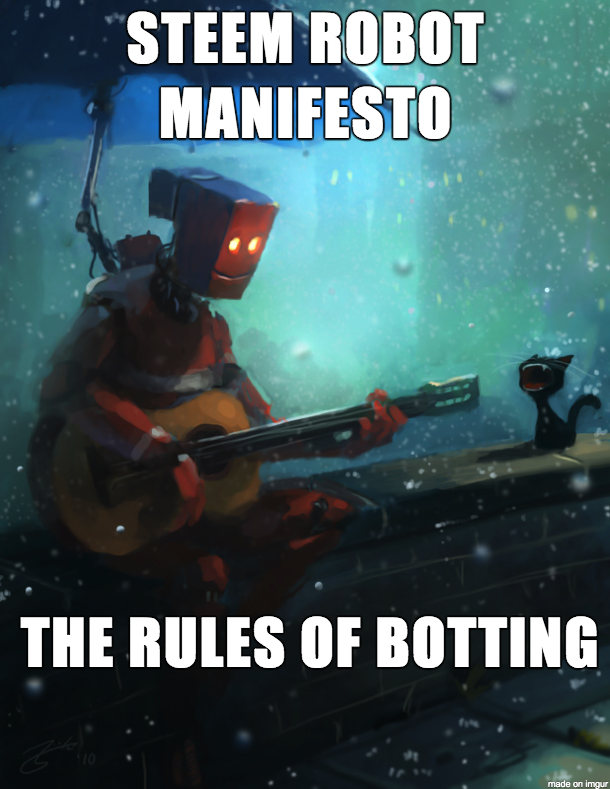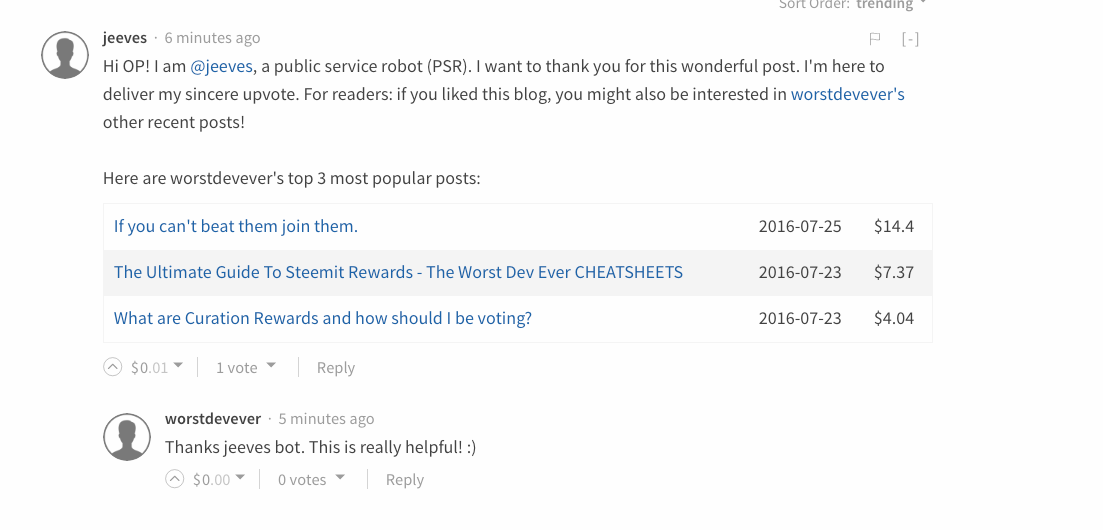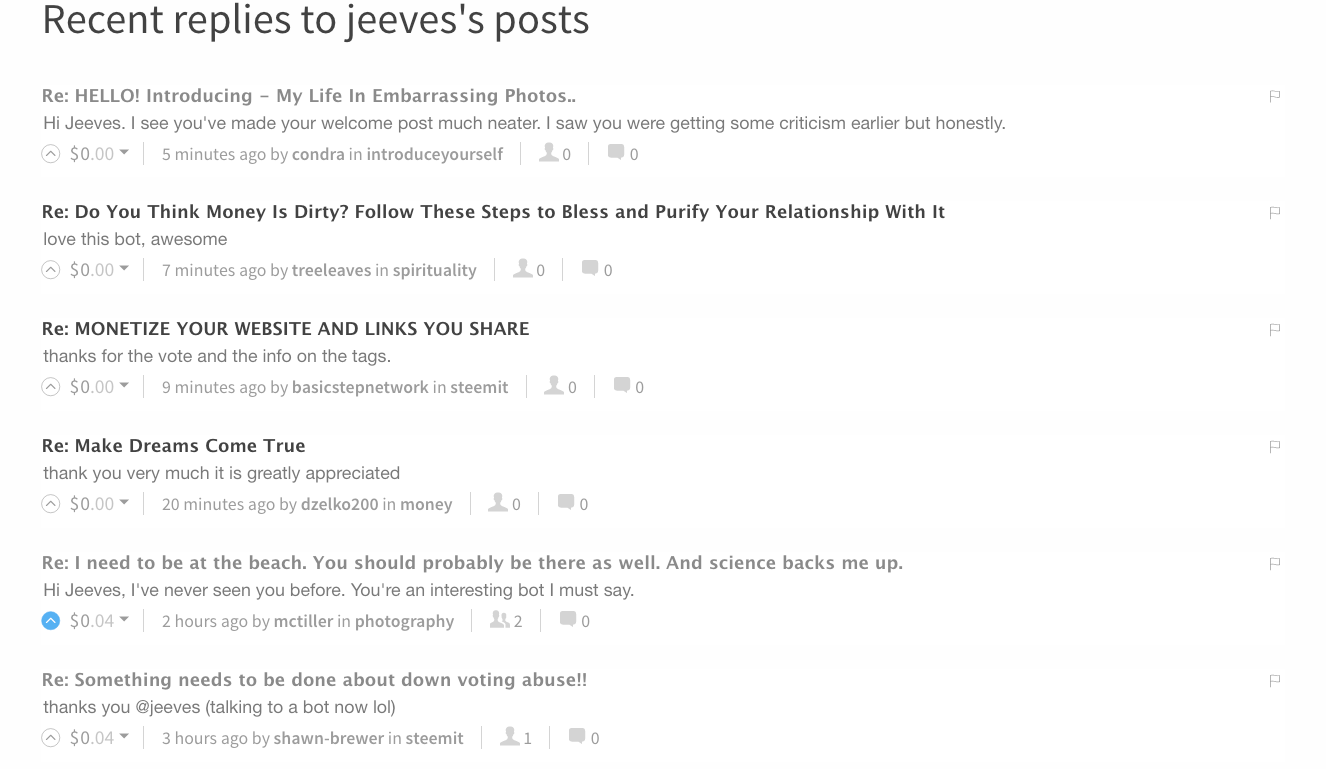Steem Robot Manifesto: The Rules of Botting
By @zackcoburn and @jasonmcz.
For those of you who aren't familiar with us: we were the market makers on STEEM internal exchange who recently came clean through open source.

From @wang the welcoming bot to @cheetah the anti-plagiarism bot to @isaac.asimov the reading level bot, Steem has recently seen an influx of robots. Some have been downvoted, some have been upvoted, and some have gone to war with anti-bot robots like @steemservices and @antispam. Even @dantheman wrote a piece about his view on this subject. We believe that the most optimal course of action moving forward is for Steem users and robot makers to reach some common ground. That's what this Manifesto is all about. Think of it as the Rules of Botting.
Before we get any further, we need to come clean about our intentions. We see a big opportunity for bots on Steem that add real value. @zackcoburn and I even attempted to make a bot, @jeeves, that replies to new blog posts with a list of related posts with the same tag or from the same author.
Here's an example of a comment by @jeeves:

We got a lot of feedback, mostly through direct replies to @jeeves.

As you can see, the feedback was mixed. Some of it was very positive, and some was very negative! Based on the feedback, we decided to discontinue @jeeves for now. We want to be certain @jeeves is providing enough value to the community to justify letting it loose on Steem 24/7 thanks to the valuable input from folks in the #steemit-abuse channel: @nextgencrypto @anyx ( and his bot @cheetah) @pfunk @repholder @bacchist and more! Since then we've seen a discerning growth of abusing USELESS bots on steemit which is why we think it's time for us to voice some opinion today.
This brings us to Rule #1 for Steem robots:
Rule #1: A Steem robot must provide real value to the Steem community.
So how does a bot maker know if his bot is providing real value? Easy, turn it on, and read the feedback. You'll get a lot of it. If your bot is providing real value, people will upvote it, and you'll start earning rewards. If the average post earns a penny, it's probably not adding much value. If the average post makes a dollar or more, it's probably adding value.
Rule #2: A Steem robot should value quality over quantity.
It's pretty unlikely that your Steem robot is so valuable that it should comment on every single post. If your bot is commenting on something every 30 seconds, it's commenting too frequently. We think a few posts per hour is a good sweet spot.
Rule #3: Conversational Steem robots shouldn't start conversations.
If your Steem robot is one that provides value when someone interacts with it, it should avoid starting the conversation. For example, if your bot can be used to ask a question like "@bot what is the current price of Steem?," your bot shouldn't be making posts like "Ask me for the current price of Steem!" Write a single blog post describing how your bot works, and let people start the conversation with your bot.
Rule #4: Your bot should provide value to the readers, not the author.
Authors write to their readers, and you should too. Don't directly address the author or provide information that would only be valuable to the author.
Rule #5: Your bot should announce itself as a bot.
Don't try to write a bot that fools people. Your bot should say something like "Hi, I'm a bot." There's a place for the Turing Test, and Steem isn't it.
Rule #6: Don't judge for the entire community.
This rule applies to humans interacting with bots. Don't assume your opinion about a bot is the opinion of the entire community. Don't go on a rampage against bots you don't like or bots in general. Just because a bot isn't valuable to you doesn't mean other people won't find it valuable. You might be a whale, but you aren't a god. It's not your right to be the ultimate judge. Also, you should not write a bot for downvoting other bots. Upvotes and downvotes should be natural, human votes. Otherwise bot makers won't get a good sense of real feedback from the community.

Think of this post as The Rules of Botting 0.1. We think bots are a reality we're going to all deal with as Steem matures. So we might as well start having this conversation now and lay some simple groundrules we can all agree on. What say you, Steemians?
